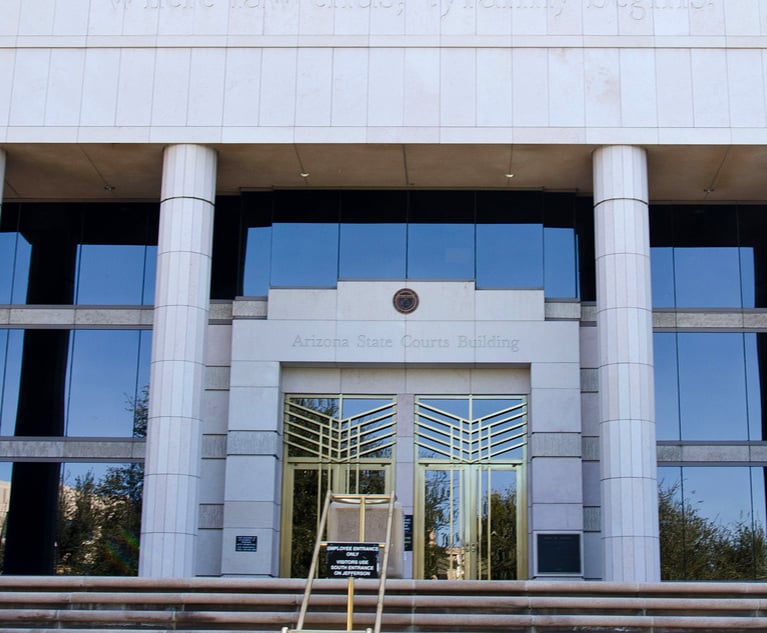Commentary: Stephenson Harwood pulling back from the abyss of irrelevance
It has been an unlikely and unheralded turnaround. It is not all that long ago that Stephenson Harwood was being written off as a basket case after a sustained period of poor financial and senior departures left this once-prestigious City brand teetering on the edge of if not collapse then something worse: irrelevance. And yet this month the firm has unveiled its fourth consecutive year of substantial turnover growth, with the top of the equity now sitting at £900,000. Headline figures put turnover 19% up on last year to just over £85m, while profits per equity partner have grown 17% to sit at an average of £620,000. This represents some 165% growth for a firm whose partner profits were loitering around the £200,000 mark just five years ago. And without any gross deviation from the roughly 50:50 split between equity and salaried partners. By any estimation, not bad going.
June 25, 2008 at 10:41 PM
4 minute read
It has been an unlikely and unheralded turnaround. It is not all that long ago that Stephenson Harwood was being written off as a basket case after a sustained period of poor financial and senior departures left this once-prestigious City brand teetering on the edge of if not collapse then something worse: irrelevance.
 And yet this month the firm has unveiled its fourth consecutive year of substantial turnover growth, with the top of the equity now sitting at £900,000. Headline figures put turnover 19% up on last year to just over £85m, while profits per equity partner have grown 17% to sit at an average of £620,000.
And yet this month the firm has unveiled its fourth consecutive year of substantial turnover growth, with the top of the equity now sitting at £900,000. Headline figures put turnover 19% up on last year to just over £85m, while profits per equity partner have grown 17% to sit at an average of £620,000.
This represents some 165% growth for a firm whose partner profits were loitering around the £200,000 mark just five years ago. And without any gross deviation from the roughly 50:50 split between equity and salaried partners. By any estimation, not bad going.
Much of the turnaround has been attributed to current chief executive Sunil Gadhia (pictured), who, as one observer comments, has got all the partners "rowing together and, what's more, rowing faster" since he took the helm in 2004 – quite a feat given the firm's once notoriously hard-to-manage partnership.
Under Gadhia, the firm has lost a lot of its flab, shedding around 20 partners and launching what was one of the toughest performance cuts made by a UK law firm to date. Although it undoubtedly bruised a few egos, the review represented the turning point.
The problematic 2002 merger with Sinclair Roche & Temperley was one of the driving forces that led the firm to take a serious look at its key sectors – at the time financial services, shipping, real estate and technology. Looking back on those years, critics see it as too narrowly-based, backing itself into a corner. The firm was linked to several potential mergers that would have engulfed it, while vulturine recruiters circled looking to pick off key teams. As one consultant summarises: "They didn't focus on much and what they chose to focus on just wasn't good enough. It was the poor relation to its pukka shipping and finance rivals."
The firm now has a markedly different outlook. A number of well-thought out hires have given it a wider base and a more synchronised feel. It has attracted talent it couldn't have dreamed of a few years ago, like aviation finance partner Paul Richardson from CMS Cameron McKenna, Nabarro transport head Mary Bonar and Addleshaw Goddard real estate partner Robert McNally among others.
The firm's finance practice is now one of the main drivers of the business, incorporating a successful aviation practice headed by former Lovells partner Guy Liddle, a robust litigation practice and a successful corporate group. Behind the figures this year is growth of over a third for the finance practice in addition to a 40% hike in revenue for the litigation practice and similar increases in corporate.
Much of Gadhia's focus for the coming year will be on continuing to build the Asia practice, which has been one of his biggest successes, with 34% revenue growth in Singapore alone this year. He is also set to put renewed emphasis on the firm's asset finance group, expanding beyond aviation and shipping to encompass a wider transportation practice. That said, one hallmark of the firm in recent years is a very tight focus, a focus Gadhia promises to maintain despite its recent successes.
Managing to sustain such striking growth for a sixth successive year in the current markets that would be impressive; nonetheless, in its new incarnation the firm is well placed to ride the rough and as the consultant comments: "They have delivered a big '**** you' [to critics] and, with partner profits like that, they have every right to be smug."
This content has been archived. It is available through our partners, LexisNexis® and Bloomberg Law.
To view this content, please continue to their sites.
Not a Lexis Subscriber?
Subscribe Now
Not a Bloomberg Law Subscriber?
Subscribe Now
NOT FOR REPRINT
© 2025 ALM Global, LLC, All Rights Reserved. Request academic re-use from www.copyright.com. All other uses, submit a request to [email protected]. For more information visit Asset & Logo Licensing.
You Might Like
View All
KPMG's Bid To Practice Law in US On Hold As Arizona Court Exercises Caution

Combative Arguments at EU's Highest Court Over Google's €4.13B Antitrust Fine Emphasize High Stakes and Invoke Trump
4 minute read
Law Firms 'Struggling' With Partner Pay Segmentation, as Top Rainmakers Bring In More Revenue
5 minute readTrending Stories
- 1Uber Files RICO Suit Against Plaintiff-Side Firms Alleging Fraudulent Injury Claims
- 2The Law Firm Disrupted: Scrutinizing the Elephant More Than the Mouse
- 3Inherent Diminished Value Damages Unavailable to 3rd-Party Claimants, Court Says
- 4Pa. Defense Firm Sued by Client Over Ex-Eagles Player's $43.5M Med Mal Win
- 5Losses Mount at Morris Manning, but Departing Ex-Chair Stays Bullish About His Old Firm's Future
Who Got The Work
J. Brugh Lower of Gibbons has entered an appearance for industrial equipment supplier Devco Corporation in a pending trademark infringement lawsuit. The suit, accusing the defendant of selling knock-off Graco products, was filed Dec. 18 in New Jersey District Court by Rivkin Radler on behalf of Graco Inc. and Graco Minnesota. The case, assigned to U.S. District Judge Zahid N. Quraishi, is 3:24-cv-11294, Graco Inc. et al v. Devco Corporation.
Who Got The Work
Rebecca Maller-Stein and Kent A. Yalowitz of Arnold & Porter Kaye Scholer have entered their appearances for Hanaco Venture Capital and its executives, Lior Prosor and David Frankel, in a pending securities lawsuit. The action, filed on Dec. 24 in New York Southern District Court by Zell, Aron & Co. on behalf of Goldeneye Advisors, accuses the defendants of negligently and fraudulently managing the plaintiff's $1 million investment. The case, assigned to U.S. District Judge Vernon S. Broderick, is 1:24-cv-09918, Goldeneye Advisors, LLC v. Hanaco Venture Capital, Ltd. et al.
Who Got The Work
Attorneys from A&O Shearman has stepped in as defense counsel for Toronto-Dominion Bank and other defendants in a pending securities class action. The suit, filed Dec. 11 in New York Southern District Court by Bleichmar Fonti & Auld, accuses the defendants of concealing the bank's 'pervasive' deficiencies in regards to its compliance with the Bank Secrecy Act and the quality of its anti-money laundering controls. The case, assigned to U.S. District Judge Arun Subramanian, is 1:24-cv-09445, Gonzalez v. The Toronto-Dominion Bank et al.
Who Got The Work
Crown Castle International, a Pennsylvania company providing shared communications infrastructure, has turned to Luke D. Wolf of Gordon Rees Scully Mansukhani to fend off a pending breach-of-contract lawsuit. The court action, filed Nov. 25 in Michigan Eastern District Court by Hooper Hathaway PC on behalf of The Town Residences LLC, accuses Crown Castle of failing to transfer approximately $30,000 in utility payments from T-Mobile in breach of a roof-top lease and assignment agreement. The case, assigned to U.S. District Judge Susan K. Declercq, is 2:24-cv-13131, The Town Residences LLC v. T-Mobile US, Inc. et al.
Who Got The Work
Wilfred P. Coronato and Daniel M. Schwartz of McCarter & English have stepped in as defense counsel to Electrolux Home Products Inc. in a pending product liability lawsuit. The court action, filed Nov. 26 in New York Eastern District Court by Poulos Lopiccolo PC and Nagel Rice LLP on behalf of David Stern, alleges that the defendant's refrigerators’ drawers and shelving repeatedly break and fall apart within months after purchase. The case, assigned to U.S. District Judge Joan M. Azrack, is 2:24-cv-08204, Stern v. Electrolux Home Products, Inc.
Featured Firms
Law Offices of Gary Martin Hays & Associates, P.C.
(470) 294-1674
Law Offices of Mark E. Salomone
(857) 444-6468
Smith & Hassler
(713) 739-1250









